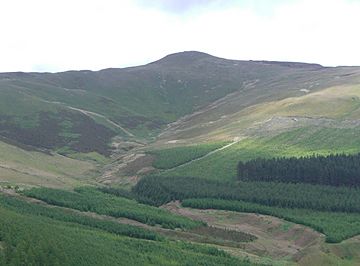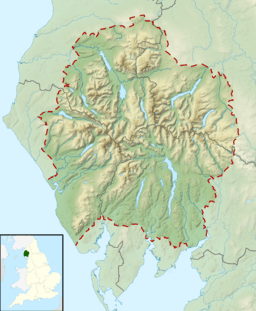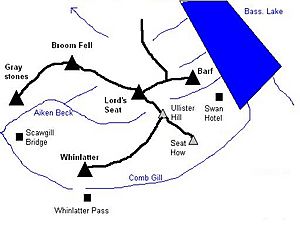Lord's Seat facts for kids
Quick facts for kids Lord's Seat |
|
|---|---|

Seen from Darling How Plantation, 2 km to the west.
|
|
| Highest point | |
| Elevation | 552 m (1,811 ft) |
| Prominence | c. 237 m |
| Parent peak | Grasmoor |
| Listing | Wainwright, Marilyn |
| Geography | |
| Location | Cumbria, England |
| Parent range | Lake District, North Western Fells |
| OS grid | NY204265 |
| Topo map | OS Landranger 89, 90, Explorer OL4 |
Lord's Seat is a beautiful hill, also known as a 'fell', located in the famous English Lake District. It's the highest point among a group of hills found north of Whinlatter Pass. Much of Lord's Seat is covered in thick forests, making it a green and peaceful place to explore.
Contents
Exploring Lord's Seat: A High Point in the Lake District
The Lake District is home to many amazing hills, called 'fells'. Lord's Seat is a special one, sitting in the north-western part of this beautiful area. It's like the main hub for the hills found between Whinlatter Pass and the Embleton Valley.
The Main Ridge of the Fells
A long line of hills, called a ridge, stretches from the Lorton Valley in the west to Bassenthwaite Lake in the east. As you travel along this ridge, you'll find important peaks like Graystones, Broom Fell, Lord's Seat, and Barf. Even though Barf is very close to Lord's Seat, it was given its own special status by Alfred Wainwright. He was a famous writer who created popular guidebooks about the Lakeland Fells.
Other Ridges and Valleys
Lord's Seat is a central point, with several other ridges branching off from it. To the southeast, there's Ullister Hill, a bare mound surrounded by many trees. Further on, you'll find Seat How, a rocky top that looks down onto the steep path to Whinlatter Pass.
Another ridge curves around from Ullister Hill, heading south and then west. This ridge ends at Whinlatter fell. Between Whinlatter and the main east-west ridge is a quiet valley called Aiken Beck.
Water Flowing from Lord's Seat
Many small streams start on Lord's Seat. Even though they flow in different directions, they all eventually join the River Derwent. Aiken Beck and its smaller streams drain the southwestern parts of the hill, which are mostly covered in pine trees.
Hagg Beck, which feeds into Beck Wythop, begins near the summit. This stream flows across open land before entering the forests. Beckstones Gill flows towards Bassenthwaite Lake, south of Barf. All the eastern sides of these hills are forested, except for the rocky face of Barf.
What is Lord's Seat Made Of?
The ground on Lord's Seat is mostly made of mudstone and siltstone. These are types of rock formed from very fine particles. Much of the top of the hill is covered in peat, which is a type of soil made from decayed plants. There's also a break in the rock, called a fault, to the southwest. Beyond this fault, you'll find greywacke sandstone, another type of rock.
Mining History on the Slopes
Long ago, people used to mine on the eastern slopes of Lord's Seat, especially below Seat How. There were four mines in this area: Ladstock, Rachel Wood, Thornthwaite, and Beckstones. Most of these mines closed in the 1870s. However, Thornthwaite and Rachel Wood kept working until December 1920. Miners mainly dug for lead and zinc ores, which are rocks containing valuable metals.
Reaching the Summit of Lord's Seat
The very top of Lord's Seat is a smooth, grassy dome. You'll find a small pile of stones, called a cairn, marking the highest point. From here, the views are amazing because it's the highest spot north of Whinlatter.
You can see the Northern Fells clearly across Bassenthwaite Lake. There's also a great view of the Helvellyn range, another famous group of mountains. While Grasmoor blocks some of the view to the south, there's nothing stopping you from seeing the Scottish Hills far away across the Solway Firth to the north!
How to Climb Lord's Seat
There are a few ways to reach the top of Lord's Seat.
- From the western side of Whinlatter Pass, you can take a nice path up the wooded Aiken Valley. This valley is quiet and doesn't allow cars.
- You can also start from the summit of Whinlatter Pass. From there, you can either climb directly up Ullister Hill or first climb Whinlatter fell and then follow the ridge.
- If you're coming from the main road along Bassenthwaite Lake, you can follow a path next to Beckstones Gill. This path goes just inside the forest and is an easier way up than the rough face of Barf.



